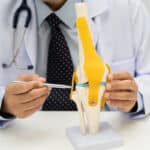
Rib cage pain can cause minimal tenderness to painful cramps or a feeling of burning. Often rib pain is caused by a spine issue, even if the chest and abdomen are more affected by the pain. Here are some potential causes of mid-spine rib pain, also known as the thoracic spine, suffering from this pain you need to visit pain management doctors in OKC.
Spinal pain is highly prevalent in the area of the lumbar (lower back) and cervical (neck) and is often the source of many missed working days. The common cause of low back pain is lumbar muscle strain and sprain. The thoracic spine may also cause spinal pain, but the thoracic spinal region is much less commonly damaged than the lumbar or cervical spine because it is much more rigid.
Thanks to its weight-bearing role and involvement in lifting, turning, and bending, the lumbar and cervical spine are susceptible to strain. Lumbar muscle strain is caused by abnormally strained or broken muscle fibers. Lumbar sprain is caused by excessively stretched ligaments the tight muscle bands that bind bones together. Both can be caused by a sudden injury or chronic overuse.
The soft tissues are inflamed when the lumbar spine is stressed or sprayed. This inflammation causes pain and can lead to spasms of the muscle. While lumbar strain or sprain can be very weakening, neither of them normally requires neurochirurgical treatment.
Spinal damage can be caused by more serious issues that may need to be treated surgically. They typically involve spinal pain that radiates from the back to the anterior chest into the arms, legs, or around the rib cage.
Pain Around Ribs and Back Symptoms
Non-surgical low back or cervical or thoracic pain affects the soft tissue of central and para-spinal without radiating around the neck, chest, or legs. On the opposite, pain from the spine into the extremities or chest wall suggests systemic pinching of the spinal nerves that may require surgical opinion if the condition with non-surgical symptomatic care does not improve within days to weeks.
Other Symptoms
-
Stiffness in the low back area reduced movement distance.
-
Inability due to fatigue and/or discomfort to maintain normal posture.
-
Movement and rest spasms of the muscle.
-
Pain that lasts for 10-14 days at most.
-
Significant loss of motor function such as tiptoe and heel walking ability.
Fractured or displaced rib
A traumatic injury, like a collision, causes fractures or displaced ribs in which it interacts with the thoracic spine. If the rib is pushed, it can cause cramps in the rib muscle, such as in the back or front. It can also squeeze the intercostal nerve and transfer pain, tingling, and numbness along the rib, into the chest, and less typically into the abdomen.
Thoracic herniated disc
While rare, a thoracic herniated disk can cause inflammatory proteins to leak from the disk and inflame a thoracic spinal nerve, causing pain along the nerve path. Pain, tingling, and/or numbness can radiate to the chest or abdomen anywhere from the herniation site in the upper back along the rib. With certain forms of operation, such as intense exercise or bending, discomfort can come and go and may intensify.
Thoracic osteoarthritis
Osteoarthritis in the thoracic occurs when protective cartilage in the thoracic spine begins to break down within the facet joints. Osteoarthritic joints are inflamed, and bones tend to rub together, which can cause bone spurs to increase.
Visit a Doctor
Call for medical attention if intense discomfort is serious enough in the rib cage region to restrict movements or does not ease with rest. However, any kind of radiating discomfort, tingling, numbness, or fatigue needs an immediate medical examination. The earlier it begins; care is usually more successful. An accurate medical diagnosis is crucial, rather than trying to ignore the pain.
Contact us for pain management doctors in OKC.
**Disclaimer: This content should not be considered medical advice and does not imply a doctor-patient relationship.






